#ron brecher
Photo
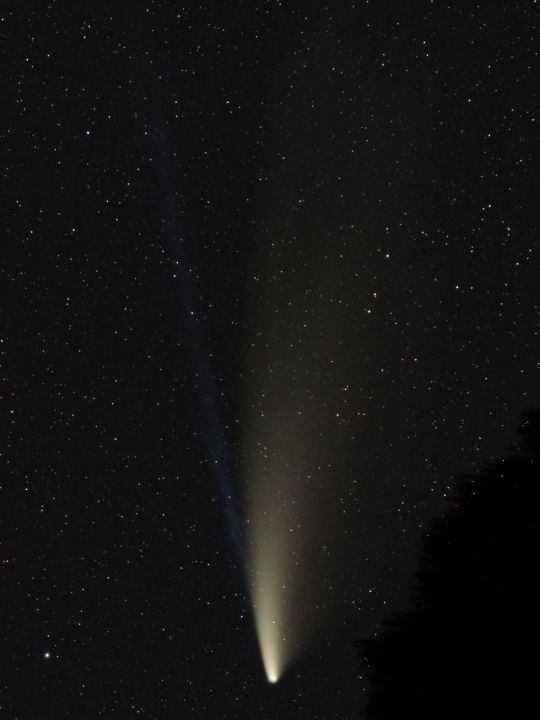
Comet C/2020 F3 (NEOWISE) by By Ron Brecher | July 17th, 2020
100 notes
·
View notes
Text

Awesome version of M-8 or Messier-8 a.k.a. the Lagoon Nebula by Ron Brecher Full Resolution 2884x2284
0 notes
Photo

0 notes
Text
Lovely Luna in Evening, Saturn Shines at Maximum, and Moonlight-Friendly Sights!
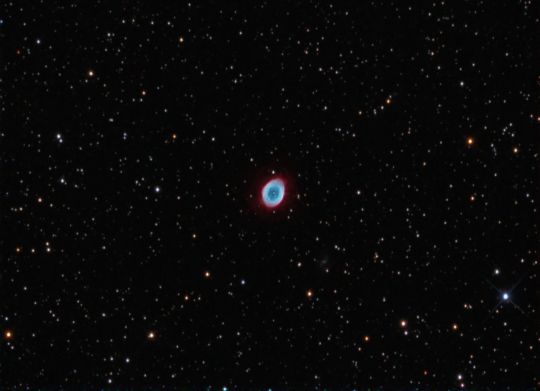
(Above: Look - a donut! The Ring Nebula in Lyra, imaged by Ron Brecher of Guelph, Ontario on July 25, 2012. His other excellent images are found at http://astrodoc.ca/ )
Hello, Summer Stargazers!
Here are your Astronomy Skylights for the week of July 7th, 2019 by Chris Vaughan. Feel free to pass this along to your friends and send me your comments, questions, and suggested topics. I repost these emails with photos at http://astrogeoguy.tumblr.com/ where all the old editions are archived. You can also follow me on Twitter as @astrogeoguy! Unless otherwise noted, all times are Eastern Time. Please click this MailChimp link to subscribe to these emails. If you are a teacher or group leader interested joining me on a guided field trip to York University’s Allan I. Carswell Observatory or the David Dunlap Observatory, visit www.astrogeo.ca.
I can bring my Digital Starlab inflatable planetarium to your school or other daytime or evening event. Contact me, and we’ll tour the Universe together!
The Moon and Planets
This is the week of the lunar month when skywatchers worldwide can enjoy the moon in the early evening sky - just ahead of next week’s 50th anniversary of Apollo 11. And, two more planets will reach opposition and maximum visibility this week. Here are the Skylights!
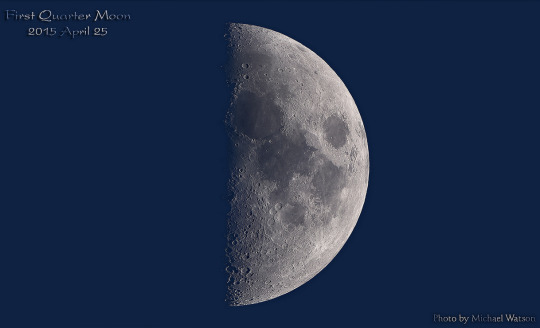
(Above: The moon at First Quarter, imaged by Michael Watson of Toronto in spring, 2015. Michael’s amazing photos can be viewed on his Flickr page here.)
Tonight (Sunday) the moon will begin the week as a pretty waxing crescent in the western, early evening sky on the border between Virgo (the Maiden) and Leo (the Lion). On Tuesday morning, the Earth-orbiting moon will reach a 90 degree angle from the sun - setting up its First Quarter phase, when it appears half-illuminated from Earth. We call this phase “first quarter” because the moon has completed one-quarter of the trip around Earth.
First quarter moons rise around noon and set around midnight. The evenings surrounding this lunar phase are the best times to look at the moon under magnification. As the sun slowly rises over the moon’s eastern horizon (which takes a week!), its steeply slanted rays of light cast deep, black shadows to the west of every elevated feature – mountains, crater rims, boulders, and even fault lines. Every hour, and every night, the zone alongside the terminator, the pole-to-pole boundary dividing the lit and dark hemispheres, creeps west - revealing new breathtaking vistas.
On Tuesday night, the moon will take up a position above (celestial north of) the very bright, white star Spica in Virgo. Over the course of several hours, you can watch the moon’s orbital motion carry it eastwards of that star. That’s toward the left for Northern Hemisphere observers, and vice versa.
On Thursday and Friday night, the waxing gibbous (which means “more than half-illuminated”) moon will visit Libra (the Scales) and then land above the up-down row of three little white stars that mark the claws of Scorpius (the Scorpion).
In the southern sky on Saturday evening, the waxing gibbous moon will land about three finger widths to the left (east) of the bright planet Jupiter. If you watch the moon and Jupiter over several hours, starting at dusk, you will see the moon’s orbit carry it farther from the planet, while the rotation of the sky will lift the moon above Jupiter.
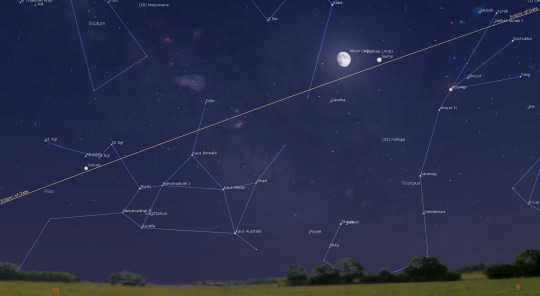
(Above: The bright gas giant planets continue to dominate the southern evening sky. On Saturday, July 13, the bright, waxing gibbous moon will land near Jupiter, as shown here for 10 pm local time.)
For about an hour after sunset on the Sunday evening, Mercury’s orbital motion downwards towards the sun will bring it less than 4 finger widths to the lower left (south) of slightly brighter Mars. The two dim planets will be very low in the north-northwestern twilit sky. Take care that the sun has completely disappeared below the horizon before attempting to search for them with binoculars or telescopes. The best time to look for Mercury falls between 9:30 and 9:45 pm local time. Mars sets nearly 30 minutes later, so you’ll have more time to look for it. Observers closer to the Equator will have a better chance to see the two planets – due to a darker sky after sunset. Mercury will drop too low to see after mid-week.

(Above: Mars and Mercury can be spotted with difficulty, low in the north-northwestern sky after sunset early this week, as shown here at 9:40 pm local time. Mercury is following its orbit downward, toward the sun.)
That incredibly bright object that you’ve been seeing in the southeastern evening sky recently is Jupiter! This week, Jupiter will be visible from dusk to almost 4 am local time. Even a backyard telescope can show Jupiter’s saucy equatorial stripes and the four Galilean moons named Io, Europa, Callisto, and Ganymede. They always appear in a rough line flanking the planet. If you see fewer than four, then some are either in front of Jupiter, or hidden behind it.
From time to time, the small, round black shadows cast by the Galilean moons become visible in amateur telescopes as they cross (or transit) Jupiter’s disk. Io’s shadow will transit Jupiter after midnight on Thursday (i.e., Friday morning) from 12:31 am to 2:43 am EDT.
Due to Jupiter’s rapid 10-hour rotation period, the Great Red Spot (or GRS) is only observable from Earth every 2nd or 3rd night, and only during a predictable three-hour window. The GRS will be easiest to see using a medium-sized, or larger, aperture telescope on an evening of good seeing (steady air). If you’d like to see the Great Red Spot in your telescope, it will be crossing the planet starting late on Monday evening (from 10:15 pm until 2:15 am EDT). More GRS viewing opportunities will occur after dusk on Tuesday and Thursday, and on Saturday night from 10:15 pm to 1:30 am EDT.
On the afternoon of Tuesday, July 9, Earth’s orbit will carry us between Saturn and the sun. Sitting opposite the sun in the sky on that date, Saturn will rise at sunset and arrive at its minimum separation from Earth of 9.0 Astronomical Units (an AU is the average sun-Earth distance). That’s 1.351 billion km, or 75 light-minutes! Saturn will shine at a peak brightness for the year (magnitude +0.05) and exhibit an apparent disk diameter of 18.4 arc-seconds. The rings, which will be getting narrower every year until the spring of 2025, will subtend 42.86 arc-seconds. (For comparison, the full moon is 1,800 arc-seconds across.) Don’t fret if Tuesday is cloudy. Saturn will look nearly as good for several days.

(Above: Saturn will reach peak visibility for 2019 on Tuesday, as shown here at 10:30 pm EDT. Look in the southeastern sky after dusk, about 30 degrees to the lower left of Jupiter.)
Yellow-tinted Saturn will remain visible all night long. Its position in the sky is just to the left (east) of the stars that form the teapot-shaped constellation of Sagittarius (the Archer). Saturn is quite a bit dimmer than Jupiter. To find it, look about 3 fist diameters to the lower left (east) of Jupiter. Dust off your telescope! Once the sky is dark, even a small telescope will show Saturn's rings and several of its brighter moons, especially Titan! Because Saturn’s axis of rotation is tipped about 27° from vertical (a bit more than Earth’s is), we can see the top surface of its rings, and its moons can appear above, below, or to either side of the planet. During this week, Titan will migrate counter-clockwise around Saturn, moving from Saturn’s right tonight (Sunday) to the upper left of the planet next Sunday. (Remember that your telescope will flip the view around.)
For night owls, distant and dim, blue Neptune is in the southeastern pre-dawn sky, among the stars of Aquarius (the Water-Bearer). The planet will be rising shortly before midnight local time this week. You’ll find the magnitude 7.9 planet sitting a thumb’s width to the left (east) of a medium-bright star named Phi (φ) Aquarii.
Blue-green Uranus will be rising at about 1:30 am local time this week. It is sitting below the stars of Aries (the Ram) and is just a palm’s width above the head of Cetus. At magnitude 5.8, Uranus is bright enough to see in binoculars.
Venus is bright enough to see within the pre-dawn twilight sky that surrounds it, but it is sitting very low in the northeast - sinking ever-closer to the rising sun. Venus will be rising at about 5 am local time all week.
But wait, there’s more! On Sunday, July 14, the dim and distant dwarf planet Pluto will also reach opposition. (After all, it IS sitting near Saturn this year.) On that date, Pluto will be the closest to Earth (4.91 billion km, or 273 light-minutes) and reach its greatest visual magnitude (+14.2) for 2019. Pluto will rise in the east at sunset and reach its highest elevation, over the southern horizon, at 1:20 am local time. While Pluto is far too dim to see in amateur-grade telescopes, an astronomy app can show you where it is compared to the brighter nearby stars. Even if you can’t see it directly, you will know that Pluto is there.
Some Moonlight-Friendly Sights
While the moon will brighten evening skies all over the world this week, there are still plenty of sights to see.
Stars shine with a colouration that is produced by their surface temperatures, and this is captured in their spectral classification. The three bright stars of the Summer Triangle, namely Deneb, Vega, and Altair, are all A-class stars that appear blue-white to the eye and have surface temperatures in the range of 7,500 to 10,000 K. High in the southwestern sky, orange Arcturus is a K-class giant star with a temperature of only 4,300 K. Finally, reddish Antares, the heart of Scorpius, is an old M-class star with a surface temperature of 3,500 K. By comparing these stars colors’ to other stars, you can estimate those stars’ temperatures. The classification letters, from hottest to coolest are: OBAFGKM. Can you think up a mnemonic phrase to remember the order? I have one.
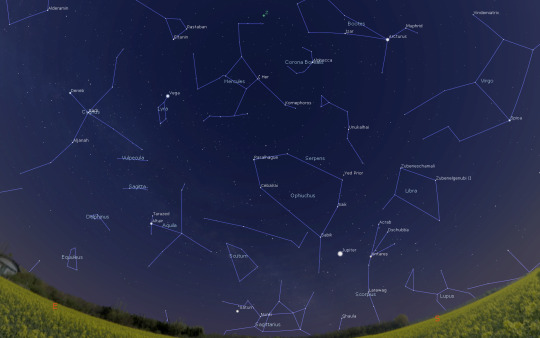
(Above: The bright stars of summer shine with different colours. Deneb, Vega, and Altair are hot white, medium-hot Arcturus is orange, and cooler Antares is closer to reddish. The sky is shown for early July at 10 pm local time.)
The constellation of Lyra (the Harp) is positioned high overhead in late evening in early July. This constellation features a coffee and a donut! Keen eyes might reveal that the star Epsilon Lyrae, located just one finger’s width to the left (east) of the bright star Vega (Alpha Lyrae), is a double star. Binoculars or a small telescope will certainly show the pair. Examining Epsilon at high magnification will reveal that each of the stars is itself a double – hence its nick-name, “the double-double”. To see the donut, aim your telescope midway between the stars Sulafat and Sheliak, which form the southern end of Lyra’s parallelogram. Messier 57, also known as the Ring Nebula, will appear as a faint grey ring. Higher magnification works well on this planetary nebula – which is the corpse of a star that had a similar mass to our sun.

(Above: The constellation of Lyra, the Harp features summertime’s brightest star, Vega. It also contains a coffee and a donut - the double double-star Epsilon Lyrae and the Ring Nebula, respectively.)
Mid-July evenings bring us one of the best asterisms in the sky, the Teapot in Sagittarius (the Archer). This informal star pattern features a flat bottom formed by the stars Ascella on the east and Kaus Australis on the west, a triangular pointed spout pointing west, marked by the star Alnasl, and a pointed lid marked by the star Kaus Borealis. The stars Nunki and Tau Sagittarii form its handle. The asterism reaches maximum height above the southern horizon around midnight, when it will look as if it’s serving its hot beverage – with the steam rising as the Milky Way!
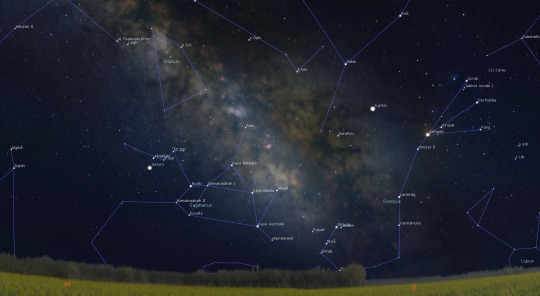
(Above: The stars of Sagittarius form a quaint Teapot-shaper asterism. The Milky Way rises like steam from its spout, as shown here at 11 pm local time in early July.)
The Summer Triangle
If you missed last week’s note about the Summer Triangle asterism, which shines high in the eastern sky every July, I posted it here.
Public Astro-Themed Events
Taking advantage of the moon and other bright objects in the sky this week, the RASC Toronto Centre astronomers will hold their free monthly public City Sky Star Party in Bayview Village Park (steps from the Bayview subway station), starting around 8 pm on the first clear weeknight this week (Mon to Thu only). You don’t need to be an RASC member, or own any equipment, to join them – looks are free! Check here for details, and check the banner on their website home page or Facebook page for the GO or NO-GO decision around 5 pm each day.
Every Monday evening, York University’s Allan I. Carswell Observatory runs an online star party - broadcasting views from four telescopes/cameras, answering viewer questions, and taking requests! Details are here. On Wednesday nights they offer free public viewing through their rooftop telescopes. If it’s cloudy, the astronomers give tours and presentations. Details are here.
On Tuesday, July 9, starting at 7 pm, U of T’s AstroTour planetarium show will be Our Musical Universe. Find tickets and details here.
Weather permitting, on Tuesday, July 9 from 9 to 10:30 pm, astronomers from RASC – Mississauga will hold a free public star party at the Riverwood Conservancy, 4300 Riverwood Park Lane, Mississauga. Details are here.
On Thursday, July 11, starting at 7 pm, U of T’s AstroTour will present their planetarium show Grand Tour of the Cosmos. Tickets and details are here.
At 2 pm on Thursday, July 11, the Cliffcrest Library will present a free public talk by Dr. John Percy, Professor Emeritus at the University of Toronto, in Astronomy & Astrophysics and in Science Education entitled The Amazing Universe. Check here for details.
If it’s sunny on Saturday morning, July 13 from 10 am to noon, astronomers from the RASC Toronto Centre will be setting up outside the main doors of the Ontario Science Centre for Solar Observing. Come and see the Sun in detail through special equipment designed to view it safely. This is a free event (details here), but parking and admission fees inside the Science Centre will still apply. Check the RASC Toronto Centre website or their Facebook page for the Go or No-Go notification.
The next RASC Family Night at the David Dunlap Observatory will be on Saturday, July 13. There will be sky tours in the Skylab planetarium room, space crafts, a tour of the giant 74” telescope, and viewing through lawn telescopes (weather permitting). The doors will open at 8:30 pm for a 9 pm start. Attendance is by tickets only, available here. If you are a RASC Toronto Centre member and wish to help us at DDO in the future, please fill out the volunteer form here. And to join RASC Toronto Centre, visit this page.
Keep looking up, and enjoy the sky when you do. I love questions and requests - so, send me some!
2 notes
·
View notes
Photo
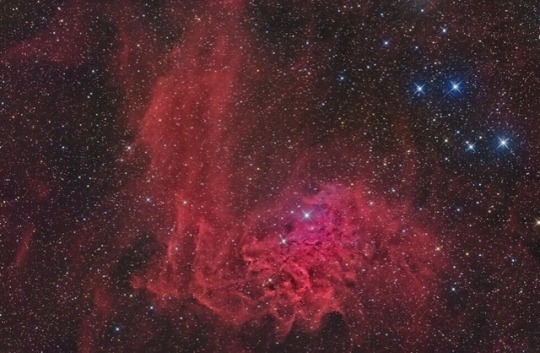
😍The Flaming Star Nebula or IC 405 📡 - - -❤️Double tap for more amazing photos -⚠️Follow for more⚠️ -🔔TURN ON POST NOTIFICATION💡 - - Photo Credit: Ron Brecher from Guelph, Ontario, Canada - - #astronomy #space #science #beauty #earth #physics #spacetravel #solarsystem #universe #cosmos #stellar #outerspace #milkyway #astro #explore #sky #nature #photography #astrophotography #nightsky #spaceship #friends #life #nasa #nebula #hubble #planet #night #travel #cosmos https://www.instagram.com/p/BvHOkbHgFZL/?utm_source=ig_tumblr_share&igshid=t9i8z7rbhwzu
#astronomy#space#science#beauty#earth#physics#spacetravel#solarsystem#universe#cosmos#stellar#outerspace#milkyway#astro#explore#sky#nature#photography#astrophotography#nightsky#spaceship#friends#life#nasa#nebula#hubble#planet#night#travel
5 notes
·
View notes
Photo

VARIETY - Rock and Roll Hall of Fame inductee Mick Fleetwood is set to executive produce a drama series currently in development at Fox. Titled “13 Songs,” the show follows rock Legend Jasper Jones and his band, The Grift, who once made music that spoke to a generation of Americans, but not anymore. Decades later, after being diagnosed with terminal cancer, Jasper is given only a few months to live. As a final love letter to his fans, he reconnects with his band to write and record 13 final songs and leave his mark on the world forever. Will Reiser and Jonathan Prince will serve as writers and executive producers on “13 Songs.” Jonathan Levine will direct and executive produce. Along with Fleetwood, Willie Mercer and Ron West of Thruline Entertainment, Gillian Bohrer of Megamix, and David Blackman of Polygram Entertainment will also executive produce. Lionsgate and Fox Entertainment will produce. Formed in 1967, Fleetwood Mac has released nearly two dozen studio albums, with the latest being “Say You Will” in 2003. The band is known for releasing hit songs such as “Dreams,” “Go Your Own Way,” and “Black Magic Woman.” Variety reported in January 2021 that Fleetwood had become the third member of the group to sell his interest in the band’s song catalog to BMG. It included Fleetwood’s interest in all of the band’s recorded work apart from their first two albums. Reiser is repped by UTA, Thruline Entertainment and attorney Jamie Feldman. Prince is repped by Rothman Brecher Erich Livingston, Thruline Entertainment and attorney Brad Small. Levine is represented by CAA and attorney Carlos Goodman. Fleetwood is repped by CAA. #mickfleetwood #fleetwoodmac https://www.instagram.com/p/CY5XGkDshdq/?utm_medium=tumblr
1 note
·
View note
Photo

Messier 101, the Pinwheel Galaxy sits above and between the stars Alkaid and Mizar in the Big Dipper’s handle. Almost as wide as the full moon, It can be seen in binoculars under dark skies. This image was taken by Ron Brecher of Guelph, Ontario. Link: http://ift.tt/2o7nM04 http://ift.tt/2ohgK8d
143 notes
·
View notes
Photo

Várias nebulosas famosas nessa região da constelação de Cygnus, NGC 7000, parte superior esquerda, IC 5067 à direita, IC 5068 parte inferior direita e LBN 332 na parte inferior. Ron Brecher fez a imagem com um Takahashi FSQ-106EDX4, mais de 14 horas de captura. https://www.instagram.com/p/B7y9SM9ptA3/?igshid=1o7iwn3f4vt1l
0 notes
Text
Globular Clusters Await: Hello, Messier 3! - Sky & Telescope
Globular Clusters Await: Hello, Messier 3! – Sky & Telescope
[ad_1]
M3 is the first of many bright globular clusters to appear in the early evening sky during “globular season.”
Photo courtesy Ron Brecher
One of my favorite seasons is globular-cluster season — and the object that best heralds its arrival is the third object listed in Charles Messier’s 18th-century catalog of non-comets, M3. Although the cluster is situated in the relatively obscure…
View On WordPress
0 notes
Text
The Coolest Photography Links Of The Week
The world of photography has been very active this week, with new articles and photographs being published everywhere that represent the very best the field has to share. This weeks list of links is composed of tutorials, special features, and great photography, all hand-curated by Toad Hollow Photography to ensure that there is something here for everyone. We really hope you like this weeks list as much as the Toad did in bringing it to you.
TUTORIALS
A Brief Introduction To Adobe Photoshop – this primer article is published here on Light Stalking, and it discusses a short overview of Photoshop, what it does, and how to interpret the interface as a new user. Screenshots included throughout the article shows you the various items covered, helping to reveal a few of the mysteries of this very powerful image production software.
Chrissie
How to Create More Visually Interesting Street Photography – this article will take you from 0 to 60 in a moment as you learn about some of the basic premises behind capturing great candid street photography. Sample shots are included as you read along, helping you to see how to apply the concepts in your own work.
Learn how to do three-point lighting like a pro – a brief 7-minute video presentation is embedded in this primer article that covers a simple portrait lighting setup. Each step is explained in detail in both the article and video, making it much easier to visualize how to apply this yourself while shooting portraits.
Anja Pietsch
An Easy Tutorial for Getting a Great Wedding Photo – check out this short video presentation that talks about how to get a great wedding photo, every time. There are, of course, countless opportunities for great images during these celebrations, and with this concept in your pocket, you are guaranteed to come away with a winner of a shot.
9 Tips for Shooting Stunning Cityscapes: Steps in Urban Photography – capturing stunning cityscapes is something that most everyone wants to try at some point in their photography practice. This short article covers 9 tips and tricks and includes some absolutely amazing examples to help get you started.
Коля Саныч
Three Methods to Convert Photos to Black and White in Lightroom – black-and-white images will always be a genre of photography that is in-style, with applications both personally as well as professionally. This 15-minute video tutorial covers three different ways of performing this transformation in Lightroom, giving you the tools you need to apply the method that works best for your desired results.
How to Store and Handle Old Photos Without Damaging Them – many of us have access to old family or archival photographs, and knowing how best to handle them is important in terms of maintaining them for future generations to enjoy. This short video presentation takes us through doing this in less than 5 minutes.
SPECIAL FEATURES
Grizzly Bear Photography in Khutzeymateen British Columbia – our love for Grizzly Bears is no real secret, so when we see posts like this one published here by Anne McKinnell we dive into it with all our hearts. Anne’s adventures result in a stunning series of intimate and candid shots of these amazing creatures in their natural habitats, living undisturbed as they have for years. For those who love wildlife photography, you won’t want to miss checking this post out.
Rolf Dietrich Brecher
Photography at 200mph – An interview with motorsports photographer Kurt Bradley – the fast-paced life of a race photographer comes alive in the great interview with a leader in the field today. This behind-the-scenes look at how someone goes about working in this specific genre of photography provides amazing insight and inspiration for those of us who love this style.
The Ultimate Guide To Taking Beautiful Pictures – with so much great learning material published online in the field of photography, it sure is great to have an article that compiles some of the best pieces into a singular list that discusses the intricacies of getting great shots. This article covers several key topics in regards to capturing great shots by sharing a select list of links to great resources covering various aspects of photography.
鎮邦
How I Found My Niche in Professional Photography – this in-depth interview features insights from a professional photographer working in the field today with a focus on large-scale industrial and architectural subjects. A great selection of sample photographs is included as the article progresses, instantly giving visual feedback and a touch of inspiration for those looking to set out on a career of their own.
The dark world of Thomas G. Anderson will make you turn the lights on – prepare to be utterly creeped out in this collection of photographs from a well-known horror photographer. These dark images are framed by the interview of the artist, giving you a little insight into what drives someone to makes images like this.
GREAT PHOTOGRAPHY
Castle – Germany is well known for its old buildings and castles, making it a perfect location to head to when looking for these character-rich structures. Pascal Schirmer captures and shares a terrific shot of a massive ancient castle that features a stunning reflection in a still body of water that sits in the foreground.
Curtis Jones
Morning Beauty – Grand Teton National Park, Wyoming – this incredible photograph of the world-famous Teton Mountains comes to us from Len Saltiel who shares some personal insights into the experiences he has while photographing these subjects alongside the image itself. The picture features beautiful golden light as it dances across the mountain tops, creating drama and a sense of depth that adds to the natural majestic beauty of the setting.
Grass Roofs – Daniel Casson uses a cinematic post-processing technique with this shot to highlight the feel of the location that features buildings and homes with grass roofs sitting in front of a dramatic mountain. A wonderful waterfall rushes down in the backdrop, adding a perfect element to the shot.
Theo Crazzolara
Moody Haifoss – let’s head over to Iceland where a world-famous waterfall dominates a rugged landscape created by eons of erosion. Johannes Hulsch’s shot takes advantage of the low lying fog that creates a muted veil over the setting, adding an ethereal feel to a shot that reveals a breathtaking view.
Seward Harbor Aerial – Ron Niebrugge shares a terrific downward looking shot of a marina lined with boats captured in Alaska. The lines from the docks and the shapes of the boats work in harmony together to create an almost abstract looking image at first glance that also has terrific detail when looked at more closely.
aotaro
Autumn Tracks – all the wonder and romance of a steam locomotive comes to life in this beautiful themed shot by Alexander Riek. As the train rounds the corner of the tracks and heads towards the camera billowing smoke, a canopy of beautiful autumn colors helps to create a frame for the scene.
Moraine Lake is gorgeous! – the Canadian Rocky Mountains are a very frequently photographed collection of mountains that reveals different personalities and sights with the changing seasons and weather. This shot was captured and shared by Jim Nix and showcases some of the intense dramatic beauty the region has to offer to those who make the trip.
Angelo Brathot
Trillium Lake at Dawn – beautiful colors and tones dance across a still lake in the early morning in this delightful photograph by Angela Chong. A lone duck slowly drifts across the water creating a gentle wake as a thin fog covers the scene to add to the incredible sense of tranquility captured here.
Street art à la Butte-aux-Cailles: “le retour (1)” – Mathias Lucas shares a terrific collection of photographs featuring various subjects and vignettes captured on the streets in France. These colorful and thoughtful compositions and vignettes showcase different aspects of life in the region, and when enjoyed as a set they also tell a wonderful story through a visual medium.
Allan Hack
New boys on the block – you can’t help but marvel when you see this terrific photo of a trio of young owls sitting about as a low sun paints the landscape around them. Jon Albert captures them at the perfect moment in this shot, as two of the feathered creatures stare back at the camera and one stares off camera right at something that has caught its eye.
Ghost Signs – Lisa Gordon does a wonderful job of capturing a set of photographs depicting various “ghost signs” in her area. These painted logos and ads on the side of buildings were completed years ago, and time has caused them to fade and weather, adding to the rich artistic tension that may soon disappear from the community’s vernacular.
Graeme Scott
Dubai – a vibrant sunset paints the sky in incredible colors as the contemporary and dramatic architecture of this famous city casts incredible forms in this amazing shot by Herbert A. Franke. Crisp details in the buildings draw the viewer into this frame where terrific features and elements await discovery.
pierre-alain pannatier
Regional Transit Authority – if you are waiting at the stop for this particular bus, you’re likely to be late for your appointment. Check out this terrific black-and-white shot from Michael Criswell of a long unused bus sitting in a nest of vegetation as time continues to ravage it through the art of decay and rust.
Bled Sunrise – Rossano Ferrari finds a terrific elevated perspective to capture this beautiful lake in Slovenia, finding a stunning sunrise full of color and joy articulated by an amazing sunburst in the photograph. As you take in the image, the tiny island in the middle of the lake that houses an ancient monastery creates a stunning anchor into the shot itself.
Timothy Neesam
Limestone Anchorage II – west coast photographer Ehpem shares a terrific monochromatic shot that looks out over the still waters of the ocean with a pair of dark islands or land masses standing as silhouettes against the sky. The waters create gentle rippled reflections of the seascape, adding a wonderful finishing element to this composition.
we missed the red tram – a quintessential winter scene greets the viewer in this amazing photograph captured during a snowstorm in the heart of a city. A red tram makes it way down the road as pedestrians walk amongst the snowflakes, creating an image that is an instant classic from e&e photography.
Thomas Hitz
Harvest Moon – a beautiful color palette covers the sky as a huge full moon lingers in the sky above the silhouetted landscape below in this shot from JayJacy Photography. A thin band of clouds creates a great texture for the colors to play with, making this picture stand out as a dramatic and beautiful example of nature’s light play.
autumn light – a muted reflection fills the front portion of this photograph as incredible colors in the autumn leaves on the trees that lead down to the pool dominate the back portion. Tiger Seo’s shot is full of rich details, adding to the inherent beauty of a fall scene.
[Read More ...]
The Coolest Photography Links Of The Week was originally posted by proton T2a
0 notes
Text
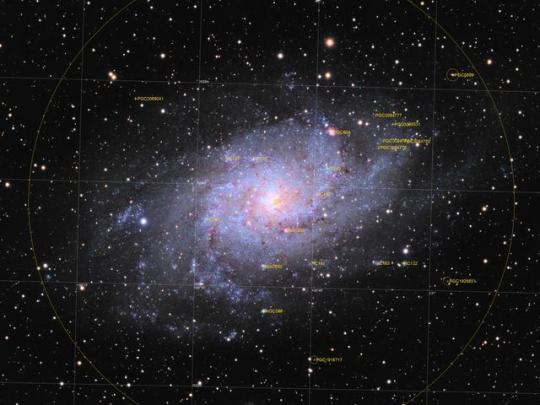
M-33 Triangulum Galaxy in HaLRGB by Ron Brecher and Terry Hancock January 2019 Annotated Version Full Resolution 3600x2700
0 notes
Text

Awesome version of M-33 a.k.a. the Triangulum Galaxy in HaLRGB by Ron Brecher & Terry Hancock 2019 full resolution 3600x2700
0 notes
Text
A Moonless Week for Orion’s Treats, and Stellar Diamonds for V-Day!

(Above: For your Valentine - the gorgeoous Heart Nebula in Cassiopeia as imaged by Ron Brecher of Guelph, Ontario. Link: astrodoc.ca/ic1805/)
Astronomy Skylights for this week (from February 4th, 2018) by Chris Vaughan. (Feel free to pass this along to friends and send me your comments, questions, and suggested topics.) I post these with photos at http://astrogeoguy.tumblr.com/ where the old editions are archived. You can also follow me on Twitter as @astrogeoguy! Unless otherwise noted, all times are Eastern Time. Please click this MailChimp link to subscribe to these emails. If you are a teacher or group leader interested joining me on a guided field trip to York University’s Allan I. Carswell Observatory, or another in your area, visit www.astrogeo.ca.
My latest column for Space.com elaborates on last week’s information about watching the obvious brightness variation in Algol, the Demon Star. You can find it here.
Public Events
Taking advantage of dark moonless evening skies this week, the members of the RASC Toronto Centre will gather for dark sky stargazing at Glen Major Forest, northeast of Claremont on (only) the first clear evening from Monday to Thursday this week. You don’t need to be an RASC member, or own any equipment, to join them. Check here for details and watch the banner on their homepage or their Facebook page for the GO or NO-GO decision around 5 pm each day.
On Monday evenings, York University’s Allan I. Carswell Observatory runs an online star party - broadcasting views from four telescopes/cameras, answering viewer questions, and taking requests! Details are here. On Wednesday evenings after dark, they offer free public viewing through their telescopes. If it’s cloudy, the astronomers give tours and presentations. Details are here.
On Tuesday, February 13, starting at 7 pm, the U of T AstroTour presents a planetarium show entitled Our Musical Universe. Tickets and details are here.
On Friday, February 16 starting at 7 pm, the U of T AstroTour presents a planetarium show entitled The Life and Death of Stars. Tickets and details are here.
The Women in Planetary Science and Exploration Conference, WPSE2018, will be held on Saturday and Sunday, February 17-18, at the Bahen Centre, U of T. Lots of amazing woman planetary scientists are presenting. Registration and details are here.
Zodiacal light
For about half an hour after dusk during the two week period between now and the new moon on February 15, look west-southwest for a broad wedge of faint light rising from the horizon and centered on the ecliptic. This is the zodiacal light - reflected sunlight from interplanetary particles of matter concentrated in the plane of the solar system. Try to observe from a location without light pollution, and don't confuse the zodiacal light with the brighter Milky Way to the northwest.

(Above: The February evening zodiacal light rises from the western horizon (at left). The Milky Way is off to the right. This image was taken last week by Fred Espenak.)
Orion’s Treats
This is a perfect week to grab the binoculars and check out Orion’s (the Hunter) majestic sword, one of winter’s true astronomical treats. The sword hangs well below Orion’s distinctive three-starred belt. Unaided eyes can generally detect three patches of light in Orion’s sword, but binoculars or a telescope quickly reveal that the middle object is not a star at all, but a bright knot of glowing gas and stars known as The Orion Nebula (or the Great Nebula in Orion or Messier 42, aka M42).
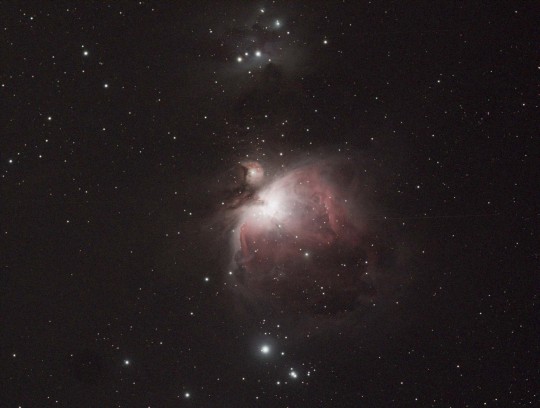
(Above: To the naked eye, Orion’s sword looks like three stars, but there’s much more to it! The Orion Nebula (M42) and Messier 43 form the centre of the sword, along with the Running Man Nebula at the top of the frame, and stars below. All are revealed in this widefield long exposure image by Manuel Guerrero of Toronto, Canada)
The Orion Nebula is one of the brightest nebulae in the entire night sky and, at 1,400 light-years from Earth, it is one of the closest star-forming nurseries to us. It’s enormous. Under a very dark sky, the nebula can be traced over an area equivalent to four full moons!
Buried in the core of the nebula is a tight clump of stars collectively designated Theta Orionis (Orionis is Latin for “of Orion”), but better known as The Trapezium, because the brightest four stars occupy the corners of a trapezoid shape. Even a small telescope should be able to pick out this four-star asterism, but good seeing conditions and a larger aperture scope will show another two faint stars. The trapezium stars are hot young O- and B-type stars that are emitting intense amounts of ultraviolet radiation. The radiation causes the gas they are embedded in to shine brightly, by both reflecting off gas and dust as blue light and also by energizing Hydrogen gas, which is re-emitted as red light. That is why there is so much purple in colour images of the nebula.
Within the nebula, astronomers have also detected many young (about 100,000 years old) concentrations of collapsing gas called proplyds that should one day form future solar systems. These objects give us a glimpse into how our sun and planets formed.
Stargazers have long known about the stars in the nebula’s core, but detection of the nebulosity around them required the invention of telescopes in the early 1600’s. In the 1700’s, Charles Messier and Edmund Halley (both famous comet observers) noted the object in their growing catalogues of “fuzzy” objects. In 1880, Henry Draper imaged it through an 11-inch refractor telescope, making it the first deep sky object to be photographed.
In your own small telescope, you should see the bright clump of Trapezium stars surrounded by a ghostly grey shroud, complete with bright veils and dark gaps. More photons would need to be delivered to your eye before colour would be observed, so try photographing it through your telescope or with a camera/telephoto lens on a tripod. Visually, start with low magnification and enjoy the extent of the cloud before zooming in on the tight asterism. Can you see four stars, or more? Just to the upper left of M42, you’ll find M43, a separate lobe of the nebula. It surrounds the unaided-eye star nu Orionis (ν Ori).
While you’re touring the sword, look just below the nebula for a loose group of stars, 1300 light-years away, called Nair al Saif “the Bright One of the Sword”. This main star is a hot, bright star expected to explode in a supernova one day. It is surrounded by faint nebulosity, too. Astronomers believe that this star was gravitationally kicked out of the Trapezium cluster about 2.5 million years ago.
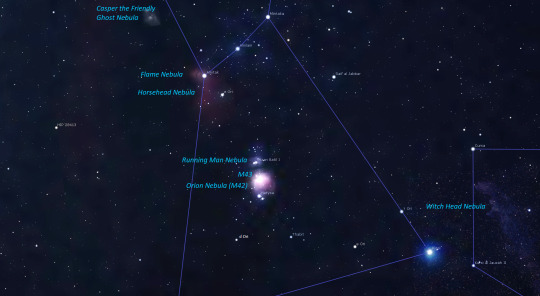
(Above: The sword below Orion’s famous belt (at top) contains the wonderful Orion Nebula and many other binocular and telescopic treats.)
Sweeping down the sword and to the left (east) brings us to the star named Mizan Batil ath Thaalith (and d Orionis) at the tip of the sword . This magnitude 4.7 star is near the limit for visibility in moonless suburban skies. About two finger widths to its right is another star of similar brightness, named Thabit, "the endurer".
Moving upwards towards Orion’s belt, half a finger width (30 arc-minutes, or the moon’s diameter) above the Orion Nebula, you’ll find another clump of stars dominated by c Orionis and 45 Orionis. A larger telescope, or a long-exposure photograph, reveals a bluish patch of nebulosity around them that contains darker lanes forming the shape of a figure, called the Running Man Nebula. This is another case of gas reflecting light from the two stars mentioned.

(Above: The Running Man Nebula in Orion’s Sword, taken by Dave Eisfeldt of Waco, Texas on Oct 26, 2011. http://eldoradostarparty.org/ngc-1977-running-man-nebula-taken-by-dave-eisfeldt-of-waco-texas/)
Just above the Running Man sits a loose cluster of a few dozen stars best seen in binoculars. Then we jump higher – most of the way towards Alnitak (the eastern-most belt star), to check out a beautiful little grouping of stars collectively called Sigma (σ) Orionis. What makes this a special treat is that, in a small telescope, we find four or five stars crammed together. Check it out with your telescope – trust me, it’s pretty! It’s a bit more than a finger width to the lower right of Alnitak. Let me know what you see!
Valentine’s Day Diamonds
A beautiful diamond sparkles in the southern sky during winter evenings. It’s Sirius, the brightest star in the constellation of Canis Major (the Big Dog). The constellation is located to the lower left (southeast) of Orion (the Hunter). In fact, his three-starred belt points directly towards Sirius! Another dog, Canis Minor (the Little Dog) sits three fist diameters to the left of Orion. It, too, has a bright star, named Procyon. The two dogs are assisting Orion in his hunt. (There is actually a dim constellation called Monoceros (the Unicorn) sitting between the two dogs, but its faint stars are barely visible from the city.)

(Above: Orion’s two canine companions, Canis Major (lower centre) and Canis Minor (beyond the Unicorn at left), pursue Lepus the rabbit across the winter evening sky. The bright stars Sirius and Procyon are fairly close to Earth, and dominate their respective constellations. Sky is shown for 8 pm local time in mid-February.)
The big dog sits lower in the sky and is oriented so that he looks like he’s standing up on his hind legs, begging Orion for a treat. Sirius marks the location of his throat – perhaps it’s a diamond dogtag! Sirius is the brightest star in the heavens (other than our sun) and its name means “scorching” in Greek. Some people call Sirius the “Dog Star”, and J. K. Rowling used its name for Harry Potter’s uncle, the animagus. Its brilliance is mostly due to its proximity to us. At only 8.7 light-years away, it is among the closest stars to Earth.
Sirius is famous for dramatic flashes of sparkling colour. Visible with unaided eyes, the colours are enhanced in binoculars or a telescope. They come from an excessive amount of twinkling due to the star’s low elevation in the sky combined with its brightness. The light from stars lower in the sky is passing through more of our atmosphere to reach us. Sirius itself is fairly ordinary. It is a few times the mass of our Sun and has a surface temperature of about 9,900° giving it a bluish colour. It is also moving towards us at about 27,000 km per hour. Fast, but don’t stand around waiting for it to arrive!
A very good telescope and a steady atmosphere can reveal Sirius’ tiny white dwarf companion star, officially named Sirius B. Astronomers have nick-named it “The Pup”, but I prefer “The Flea”. The Flea may be small but it’s mighty! Its temperature is about 25,000°!

(Above: A Hubble Space Telescope image of Sirius. Its tiny companion star Sirius B, aka The Pup, is the tiny dot at lower left.)
Procyon is another neighbour – only 11.5 light-years away from Earth - making it the eighth brightest star in the heavens. Its name comes from the Greek προκύον (prokyon), meaning "before the dog", because it rises before Sirius. It’s comparable in size to Sirius, but is slightly warmer in colour.
Take your Valentine outside on the next clear evening and show them these celestial diamonds!
The Moon and Planets
The moon spends this week largely absent from the evening sky. On Monday and Tuesday, you might glimpse its slim old crescent low in the western sky just before sunrise. Mid-week, the moon disappears beside the sun – reaching its new moon phase on Thursday afternoon. This new moon will also generate a partial solar eclipse that is only visible from the daylit portions of Antarctica (about 2/3 of the continent) and southern South America.
On Friday, the slim young crescent moon will return to the evening sky, visible low over the western horizon for a short time after sunset. On the weekend the moon’s “Cheshire Cat’s smile” will hang prettily in the western early evening sky.

(Above: Venus starts a long climb away form the sun in the western evening sky this week. On Friday, the young crescent moon will sit 2 degrees to Venus’ upper left. The sky is shown at 6:15 pm local time.)
Towards the end of this week, you can start looking for bright Venus very low over the western horizon for half an hour after sunset. The best chance to see it falls between about 6 and 6:30 pm local time. On Friday, the very young crescent moon will sit only two finger widths to the upper left of our sister planet. Venus is just beginning a long stay in the evening sky that will kick into high gear this spring.
The rest of the bright planets are still hanging out in the eastern pre-dawn sky. Extremely bright Jupiter rises first, shortly after 1 am local time, so it reaches an elevation of about three fist diameters above the southern horizon by sunrise. You can’t miss it. Dimmer, reddish Mars is sitting about two fist diameters to the lower left of Jupiter this week, but it’s slowly moving downwards towards Saturn. Those two planets rise about 2:45 am and 4:30 am local time respectively.
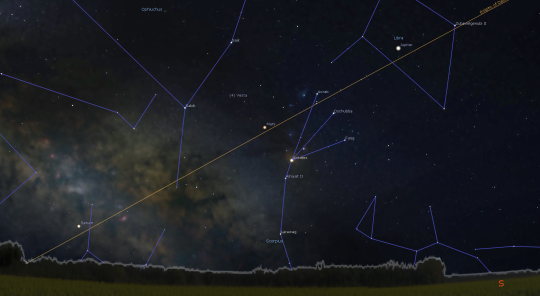
(Above: The southeastern pre-dawn sky features very bright Jupiter, then dimmer reddish Mars, and finally medium-bright yellowish Saturn. Mars is above its stellar twin the bright star Antares in Scorpius.The sky is shown for 5:30 am local time, but Jupiter will be visible until sunrise.)
Asteroid/minor planet fans can hunt down Vesta and the dwarf planet Ceres this week. Vesta is located only 5.5° (a palm’s width) to the upper left of Mars. Brighter Ceres is in Cancer (the Crab) in the eastern evening sky. Since the stars of Cancer are so dim, look for Ceres roughly midway between the bright stars Algenubi, which is the nose of Leo (the Lion) and Pollux, the lower of the twin stars in Gemini. Ceres remains visible all night long. You’ll need binoculars or small telescopes to see these two objects.

(Above: The dwarf planet (formerly asteroid) Ceres is conveniently located in the evening sky in Cancer this month, between the head of Leo (at bottom) and the twins of Gemini. Sky shown is for 8 pm local time.)
Keep looking up to enjoy the sky! I love getting questions so, if you have any, send me a note.
#Zodiacal Light#Sirius#Canis Major#Procyon#Orion's sword#Orion Nebula#Running Man#Ceres#Vesta#Jupiter#planets#space#astronomy
3 notes
·
View notes
Text

M-13 Cluster 4000x3000 Annotated version by Ron Brecher
0 notes
Text
New Moon near Mercury and Mars, Crescent Moon near the Beehive, and the Big Dipper is a Sky Tool!

(Above: This image, taken by Ron Brecher of Guelph, Ontario on May 1, 2017, shows a set of galaxies known as Markarian’s Chain. The patch of sky covered by this image spans about 3.5 degrees, or 7 full moon diameters. It is in the southwestern evening sky, midway between the bright stars Vindemiatrix in Virgo and Denebola in Leo. Ron’s other images are found at www.astrodoc.ca)
Hello, Stargazers!
Here are your Astronomy Skylights for the week of June 2nd, 2019 by Chris Vaughan. Feel free to pass this along to your friends and send me your comments, questions, and suggested topics. I repost these emails with photos at http://astrogeoguy.tumblr.com/ where all the old editions are archived. You can also follow me on Twitter as @astrogeoguy! Unless otherwise noted, all times are Eastern Time. Please click this MailChimp link to subscribe to these emails. If you are a teacher or group leader interested joining me on a guided field trip to York University’s Allan I. Carswell Observatory or the David Dunlap Observatory, visit www.astrogeo.ca.
I can bring my Digital Starlab inflatable planetarium to your school or other daytime or evening event. Contact me and we’ll tour the Universe together!
Public Astro-Events
Taking advantage of dark moonless evening skies this week, astronomers with the RASC Toronto Centre will gather for dark sky stargazing at Long Sault Conservation Area, northeast of Oshawa on (only) the first clear evening (Monday to Thursday) this week. You don’t need to be a RASC member, or own any equipment, to join them. Check here for details and watch the banner on their homepage or their Facebook page for the GO or NO-GO decision around 5 pm each day.
Every Monday evening, York University’s Allan I. Carswell Observatory runs an online star party - broadcasting views from four telescopes/cameras, answering viewer questions, and taking requests! Details are here. On Wednesday nights they offer free public viewing through their rooftop telescopes. If it’s cloudy, the astronomers give tours and presentations. Details are here.
On Thursday, June 6, starting at 7 pm, U of T’s AstroTour will present their planetarium show The Life and Death of Stars. Tickets and details are here.
On Thursday, June 6 at 9 pm, U of T’s AstroTour will present a free public talk entitled Whispers from the Cosmos, about gravitational waves. Details are here.
Eastern GTA sky watchers are invited to join the RASC Toronto Centre and Durham Skies for solar observing and stargazing at the edge of Lake Ontario in Millennium Square in Pickering on Friday evening, June 7, from 6 pm to 11 pm. Details are here. Before heading out, check the RASCTC home page for a Go/No-Go call in case it's too cloudy to observe. The rain date is Saturday.
If it’s sunny on Saturday morning, June 8 from 10 am to noon, astronomers from the RASC Toronto Centre will be setting up outside the main doors of the Ontario Science Centre for Solar Observing. Come and see the Sun in detail through special equipment designed to view it safely. This is a free event (details here), but parking and admission fees inside the Science Centre will still apply. Check the RASC Toronto Centre website or their Facebook page for the Go or No-Go notification.
The next RASC Lecture Night at the David Dunlap Observatory will be on Saturday, June 15. There will be sky tours in the Skylab planetarium room, space crafts, a tour of the giant 74” telescope, and viewing through lawn telescopes (weather permitting). The doors will open at 8:30 pm for a 9 pm start. Attendance is by tickets only, available here. If you are a RASC Toronto Centre member and wish to help us at DDO in the future, please fill out the volunteer form here. And to join RASC Toronto Centre, visit this page.
The Moon and Planets
The moon will be at its New Moon Phase, passing between the Earth and the sun, tomorrow (Monday) morning. That leaves it absent from the night time sky tonight and tomorrow. If you have clear skies in Sunday night, grab your binoculars and telescopes and get outside! I highlighted some good objects to look at on moonless nights here and here.
The very young crescent moon will rejoin the western evening sky on Monday after sunset, but you’re more likely to see it on the following evening, when it will be positioned less than a palm’s width to the left (southeast) of the planet Mercury. The moon and Mercury will both be visible sitting very low over the northwestern horizon after sunset, surrounded by evening twilight. The best time to see them will occur between 9:15 and 10 p.m. local time when the sky will be darker. Mercury will become a little easier to see every night as it swings wider from the sun.
The moon and Mercury are both being illuminated by the sun. But the moon will show a thin crescent while Mercury, viewed in a telescope, will show a largely full disk. That is because the moon is closer to us than the sun, while Mercury is on the far side of the sun. Events like these, when solar system objects displayed differences in illuminated appearance, allowed early astronomers to reason out the geometry of our solar system.
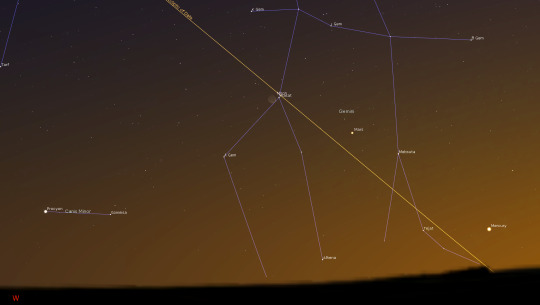
(Above: On Wednesday evening, the waxing crescent moon will appear in the sky with Mars and Mercury, as shown here at 9:50 pm local time. Parts of eastern North America can see the moon occult the star Wasat, which marks the waist of Pollux.)
During early evening on Wednesday, the young crescent moon will sit less than a palm’s width to the upper left (east) of the reddish planet Mars. Look for the pair in the north-northwestern sky among the stars of Gemini before they set at about 11 pm local time. On the same evening, the crescent moon will be sitting very close to a medium-bright, double star named Wasat (also known as Delta Geminorum). That star marks the waist of Gemini’s easterly twin, Pollux.
Observers located in the southern and eastern portions of the continental USA can watch the crescent moon occult that close pair of stars at about 9:30 pm EDT. To see the moon’s dark leading edge cover them (they’ll suddenly wink out), be sure to start watching the event before about 9 pm EDT. The sky won’t be dark yet, but binoculars and backyard telescopes will still show Wasat near the moon. Every minute, the moon will creep closer to the star. To find out exactly when the occultation starts and ends where you live (it varies), use a free astronomy app like SkySafari 6 or Star Walk 2, or load Stellarium on your computer.
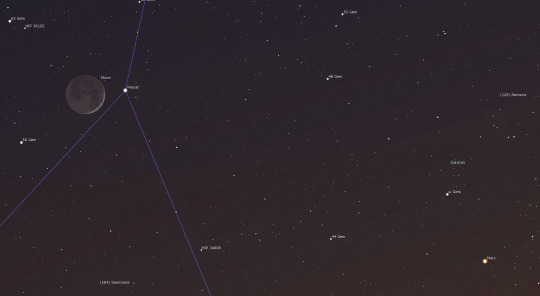
(Above: On Wednesday evening, parts of eastern North America can see the moon occult the double star Wasat, which marks the waist of Pollux. The mid-point of the occultation will occur at about 9:30 pm EDT, but the start time and duration depends on latitude. Use an astronomy app or watch the moon approach the star once the sky darkens sufficiently. This image shows the event from the GTA at 10 pm EDT, where the moon will miss Wasat.)
On Thursday night, the waxing crescent moon will move into Cancer (the Crab). The moon will set a little before midnight local time. Once the sky becomes fully dark, grab your binoculars and head outside. The moon will be situated within a few finger widths to the lower right (west) of the big open star cluster called the Beehive (or Messier 44). The slim moon and the cluster’s loose knot of dozens of stars should all fit within your binoculars’ field of view. Just put the moon in the lower right part of the binoculars’ view and look for lots of stars in the upper left. To help you navigate Asellus Australis, Cancer’s brightest star, will shine about two finger widths to the left of the star cluster. Use that star to find the Beehive even after the moon moves away.
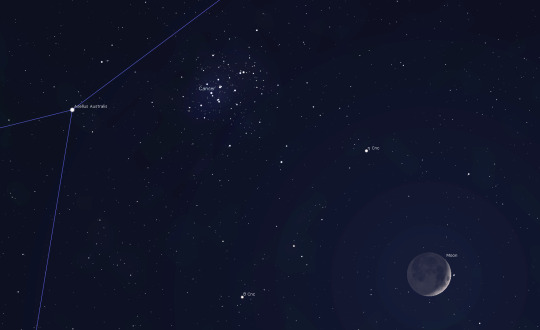
(Above: On Thursday evening, the waxing crescent moon will land to the lower left of the big open star cluster known as the Beehive and Messier 44, as shown here at 10 pm EDT. Binoculars will show the moon and the cluster together.)
On Saturday night, the nearly half-illuminated moon will land a few finger widths above the bright, white star Regulus, in Leo (the Lion).
Jupiter will shine as a blazing beacon of light in the eastern sky all night after it rises at about 9 pm local time. Due to Jupiter’s rapid 10-hour rotation period, the Great Red Spot (or GRS) is only observable from Earth every 2nd or 3rd night and only during a predictable three-hour window. The GRS will be easiest to see using a medium-sized, or larger, aperture telescope on an evening of good seeing (steady air).
If you’d like to see the Great Red Spot in your telescope, it will be crossing the planet after midnight tonight (Sunday). More GRS viewing opportunities occur in the hours surrounding 10:30 pm EDT on Wednesday evening, after 11 pm EDT on Friday.
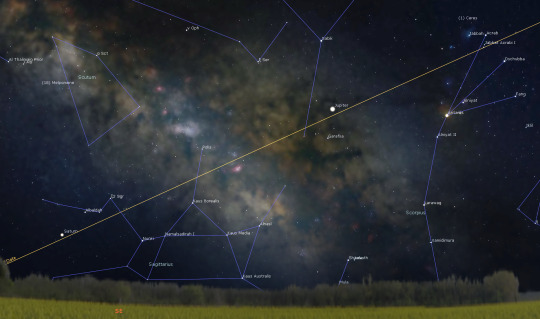
(Above: Bright, white Jupiter (at centre) and dimmer, yellowish Saturn (at lower left) will grace the southern overnight sky, as shown here at midnight. The dwarf planet Ceres will be sitting above Scorpius at top right.)
Yellowish Saturn will be rising a little before 11:15 pm local time this week. It is sitting in the area just to the left (east) of the stars that form the teapot-shaped constellation of Sagittarius (the Archer). It’s noticeably dimmer than Jupiter and will be located about 2.5 fist diameters to the left (east) of Jupiter all summer. Dust off your telescope because even a small one will show its rings and several of its brighter moons!
Distant and dim, blue Neptune is in the southeastern pre-dawn sky, among the stars of Aquarius (the Water-Bearer). The planet will rise before 2:30 am local time. After mid-June, it will be part of the evening sky. Brighter, blue-green Uranus is rising at about 4:30 am local time, among the stars of Aries (the Ram).
Last to rise is our bright, next-door neighbour Venus. She is sitting low in the east-northeastern pre-dawn sky this week, creeping ever-closer to the rising sun. Venus will shine with a steady, unmoving light - unlike airplanes.
The Big Dipper as a Sky Tool
At this time of year the Big Dipper asterism, part of the larger constellation of Ursa Major (Big Bear), sits just to the west of the zenith after dusk. When viewed while facing northeast, the dipper’s downward-facing bowl spills into its little counterpart, and its handle points to the right. Continue the arc of the dipper’s handle and “Arc to Arcturus”, the bright orange star in Böotes (the Herdsman). Continue the arc farther to “Spike to Spica”, the brightest star in Virgo (the Maiden). Extending a line from the double star Mizar at the bend of the dipper’s handle, and diagonally through the dipper’s bowl stars, you will “Cast to Castor” in Gemini (the Twins).
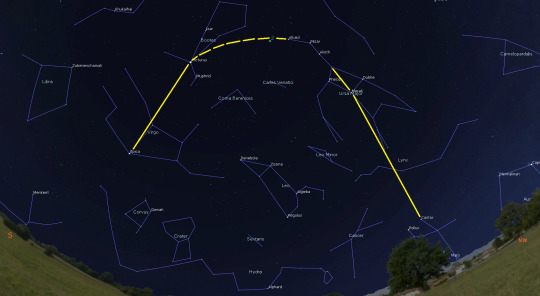
(Above: As shown here at 10:30 pm local time in early June, you can use the Big Dipper asterism to point to arc to the bright star Arcturus, spike to Spica, and cast to Castor. Practice measuring the 5 by 10 degree dimensions of the bowl and the dipper’s full 25 degree length.)
You can use the Big Dipper to practice how to specify how far apart in the sky objects are. The depth of the bowl is 5 degrees. For most people, that’s equivalent to three or four finger widths (with your hand at arm’s length). The width across the bowl is 10 degrees, or about a clenched fist’s width. The length of the dipper from the star Alkaid at the handle-tip to Dubhe at the far rim, is 25 degrees. Most people can span this with a surfer’s salute – outstretched thumb-tip to pinky fingertip. Kids’ hands are smaller, so the angles I quoted above will be smaller for them.
And don’t forget that the moon covers only half of a degree – so even a child can cover it with the tip of a pinky finger at arm’s length. Try it this week!
Keep looking up, and enjoy the sky when you do. I love questions and requests - so, send me some!
#astronomy#stars#constellations#galaxies#Big Dipper#occultation#Wasat#New Moon#Markarian's Chain#Leo#Mars#Jupiter#Great Red Spot#Mercury
0 notes
Text
Pretty Evening Planets, a Late-rising Last Quarter Moon, and Gigantic Galaxy-Gazing!
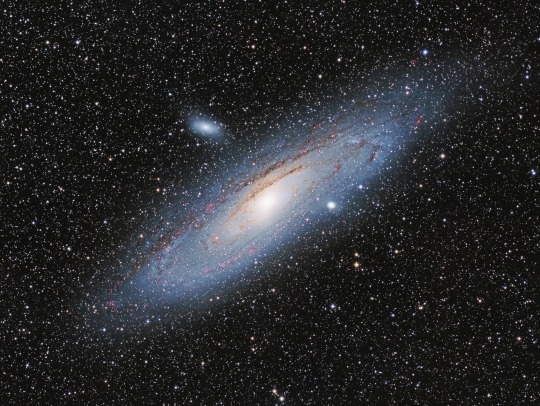
(Above: The Andromeda Galaxy, also known as Messier 31, imaged in December, 2016 by Ron Brecher of Guelph, Ontario. Foreground galaxy M32 sits to the lower right and background galaxy M110 is towards the upper left. Your telescope may flip this image.)
Astronomy Skylights for this week (from September 30th, 2018) by Chris Vaughan. (Feel free to pass this along to friends and send me your comments, questions, and suggested topics.) I post these with photos at http://astrogeoguy.tumblr.com/ where the old editions are archived. You can also follow me on Twitter as @astrogeoguy! Unless otherwise noted, all times are Eastern Time. Please click this MailChimp link to subscribe to these emails. If you are a teacher or group leader interested joining me on a guided field trip to York University’s Allan I. Carswell Observatory, or another in your area, visit www.astrogeo.ca.
If you’d like me to bring my Digital Starlab inflatable planetarium to your school or other daytime or evening event, visit DiscoveryPlanetarium.com and request me. We’ll tour the Universe together!
Public Events
Every Monday evening, York University’s Allan I. Carswell Observatory runs an online star party - broadcasting views from four telescopes/cameras, answering viewer questions, and taking requests! Details are here. On Wednesday evenings after dark, they offer free public viewing through their telescopes. If it’s cloudy, the astronomers give tours and presentations. Details are here.
On Saturday, October 6, starting at 7 pm, the U of T AstroTour will present their planetarium show entitled The Life and Death of Stars. Tickets and details are here.
On Wednesday, October 3, 2018 at 7 pm, the Perimeter Institute in Waterloo will host a free talk and webcast by Dr. Avery Broderick entitled The Event Horizon Telescope. Registration and details are here.
The next RASC Public Event at the David Dunlap Observatory will be a Speaker Night on Saturday, October 20 – and it’s all about the Moon! There will be a lecture by an astronomer, a tour of the giant 74” telescope, and viewing through lawn telescopes (weather permitting). The doors will open at 6:30 pm for a 7 pm start. Attendance is by tickets only, available here. If you are a RASC member and wish to help us at DDO in the future, please fill out the volunteer questionnaire here. And to join RASC, visit this page.
The Moon and Planets
The moon will be rising late this week, appearing over the eastern horizon after midnight local time and then lingering into the morning daytime sky. It will reach its Last Quarter phase on Tuesday morning. At that time, it will sit at a 90° angle to the sun and Earth, and appear half illuminated, on the left-hand side (as viewed from the Northern Hemisphere).
In the pre-dawn eastern sky on Wednesday morning, the eastward orbital motion of the waning crescent moon will carry it less than 2 finger widths to the lower right of the large open star cluster known as the Beehive (or Messier 44). Minimum separation will occur at about 5 am EDT. During the coming weekend, the slim crescent moon will make a pretty sight low in the eastern sky before dawn.
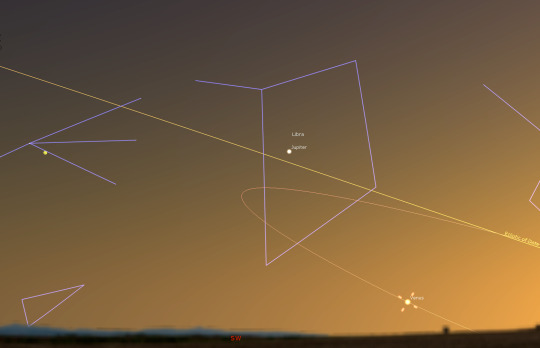
(Above: The western evening sky this week features the two bright planets Venus and Jupiter, as shown here at 7:20 pm local time.)
This week, very bright Venus will be visible low in the western sky for only a short period after sunset. Tonight, it will set at 7:35 pm, only 40 minutes after the sun. In a small telescope, Venus’ disk will resemble a slim crescent moon, lit only on the sunward side (although your telescope might flip the view). The planet is still growing larger in apparent diameter because it is travelling towards the Earth right now.
Jupiter has been carried towards Venus by the westerly motion of the sky. This weekend, it is only 1.4 outstretched fist diameters to Venus’ upper left. But Venus is outpacing Jupiter as she swings towards the sun – so they won’t get closer than they are now. We are finished with decent telescope views of Jupiter for this year. By the time the sky gets dark at 8 pm local time, the mighty planet will sit less than a fist’s diameter above the southwestern horizon. It will set in the west-southwest at about 8:45 pm local time. Using binoculars, try to see Jupiter’s four Galilean moons (Io, Europa, Callisto, and Ganymede) forming a line to either side of the planet.
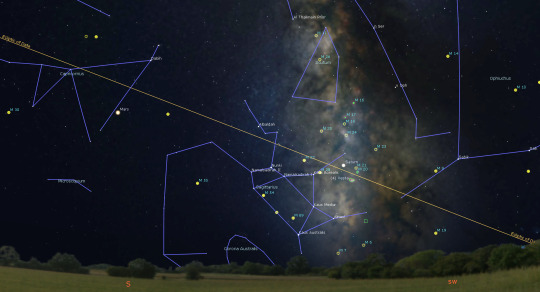
(Above: Bright reddish Mars and dimmer yellowish Saturn will sit above the southern horizon during early evening this week, as shown here at 9 pm local time.)
Brighter, reddish Mars and dimmer, yellow-tinted Saturn occupy the southern sky after dusk now. At 8 pm local time, both planets will be about two fist diameters above the horizon, with Mars about 3 fists east (left) of Saturn. Mars will set in the west after 1:30 am local time. It’s still well worth looking at, even in a small telescope. Try to see a small white oval near the top of its disk. That’s the southern polar cap!
Saturn will set in the west before 11:30 pm local time. This summer, the ringed planet has been 5 finger widths to the upper right of the “lid” star of the Teapot in Sagittarius (the Archer). As the sky darkens, even a small telescope should be able to show you some of Saturn’s larger moons, especially its largest satellite, Titan. Using a clock’s dial analogy, Titan will move counter-clockwise this week - from a position at 11 o’clock (nearly above Saturn) to 7 o’clock (nearly below Saturn). (Remember that your telescope might flip and/or invert the view. Use the moon to find out how your telescope changes things and keep a note of it, since that will always be the case.)
Distant Neptune recently reached opposition, so it is visible all night and almost its closest and brightest for this year. Using a decent quality telescope you can see the very blue planet among the dim stars of Aquarius (the Water-bearer). Look for the magnitude 7.8 planet sitting midway between the modestly bright star Phi (φ) Aquarii and the brighter star Hydor (Lambda Aquarii). It will highest in the sky (best viewing conditions) at about midnight local time.
Blue-green coloured Uranus is visible nearly all night, too. You can see it without optical aid under very dark skies, but binoculars and telescopes work better, especially with this week’s bright moon. The ice giant planet is located in the eastern mid evening sky, about 4 finger widths to the left of the modestly bright star Torcular (Omega Piscium). That star sits a generous palm’s width above the “V” where the two starry cords of Pisces (the Fishes) meet. Through the night, the planet will be carried higher – making it easier to see.
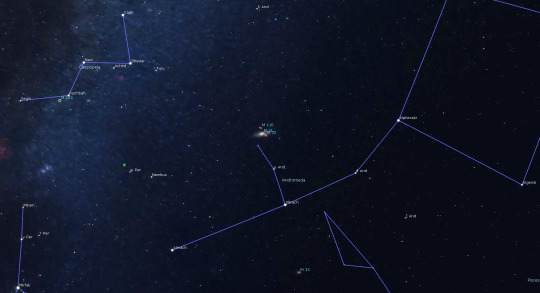
(Above: The naked-eye galaxy Messier 31, plus satellite galaxies Messier 32 and Messier 110, together sit eight degrees above the medium-bright star Mirach in Andromeda, as shown here at 9 pm local time. The top three stars of Cassiopeia can be used as pointers. The big Triangulum Galaxy, designated M33, sits below Mirach.)
Seeing Giant Galaxies
This is the season to look for the farthest object a human eyeball can see without help* – the Andromeda Galaxy, or Messier 31. This large spiral galaxy is a sister to our own Milky Way galaxy. It sits 2.5 million light-years away from our sun, meaning that its stars’ light has been journeying for that length of time. And, if there are alien astronomers there looking at us, they are seeing our solar system as we were 2.5 million years ago!
Under dark skies, using unaided eyes only, you should be able to see a faint fuzzy patch that is elongated left and right. The galaxy spans six full moon diameters across the sky, but only its bright core and surrounding, dimmer halo are usually seen visually. It’s quite easy with binoculars.
Because their fields of view are too narrow to see the entire galaxy, small telescopes generally only show its bright core. Be sure to look for M31’s two companions, the small elliptical galaxies designated M32 and M110. M32 is close to the big galaxy’s core and situated just to the lower right. M110 is above the main core and slightly farther away. At 2.49 million light-years, M32 is closer to us than the Andromeda Galaxy. M110 is 200,000 light-years farther away.
To find M31, you can first find the medium-bright star Mirach. It’s the second star east of the eastern corner of the Great Square of Pegasus. Then look for a dimmer star about 4 finger widths above Mirach. The galaxy is higher by the same distance. Alternatively, you can use the highest three stars of the W-shaped constellation Cassiopeia (the Queen). Those three bright stars form an arrow that points directly at M31.
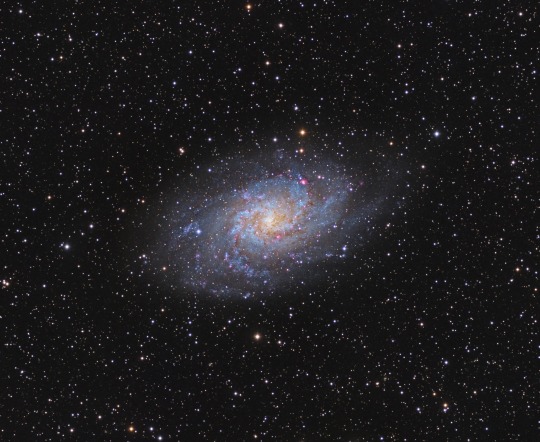
(Above: The Triangulum Galaxy, also known as Messier 33, imaged in December, 2017 by Ron Brecher of Guelph, Ontario.)
*Another large galaxy, called Messier 33 in Triangulum (the Triangle), is 2.75 million light-years away. Observers with very keen eyes under very dark sky conditions can sometimes see it, too – setting the record. This galaxy is tougher because it is oriented nearly face-on to Earth – so its light is spread across a larger patch of sky, making it dimmer overall. It sits only 1.3 fist diameters below M31, a palm’s width below the star Mirach.
Keep looking up to enjoy the sky! I love getting questions so, if you have any, send me a note.
#astronomy#stars#planets#galaxies#Messier 31#Messier 33#Andromeda Galaxy#Triangulum Galaxy#Mars#Venus#last quarter moon
0 notes